In a recent blog, we defined the various types of fabrics used in apparel production and offered suggestions on which are best for certain applications.
Today we’re going to turn our attention to the various types of apparel available for corporate branding purposes. While the categories are pretty basic—essentially shirts and outerwear—there are certain styles and treatments that impact the look and feel of the final product, which ultimately affects the perception of your brand. Much of what follows may be common knowledge, at least for some, but it provides a nice summary you or your team can consult when considering future purchases to ensure they are investing in the right items for the right audience.
Let’s get started.
Shirts vs. Outerwear
The best place to start, as they say, is at the beginning. For this discussion, that means establishing what we mean by “apparel.”
As mentioned above, we can essentially break this topic down into two broad categories: shirts and outerwear. What’s the difference?
Simply put, “shirts” is the general term used to describe a variety of upper-body garments while “outerwear” applies to items typically worn over other clothing.
Under the “shirts” umbrella, you’ll find familiar terms such as:
- T-shirts: Casual, short-sleeved garments typically made of cotton or cotton blends.
- Polo shirts: Commonly referred to as golf or tennis shirts, these items include a collar, a placket with two or three buttons, and—sometimes—a pocket. Featuring a T- or Y-shaped neckline and a short, straight hem at the bottom, polo shirts—typically made of knitted cotton or a cotton-poly blend—are considered slightly dressier than t-shirts.
- Dress shirts: Also known as "button-ups,” these shirts are designed to be worn with formal or business attire. Characterized by a button-up front, collar, long sleeves, and cuffs, dress shirts are typically made of cotton or a cotton blend and come in a variety of colors and patterns.
- Blouses: Essentially a women's dress shirt, offering a more tailored or formal design. Thanks to their versatility, blouses to be worn with both professional and casual outfits and styled to suit various looks and personal preferences.
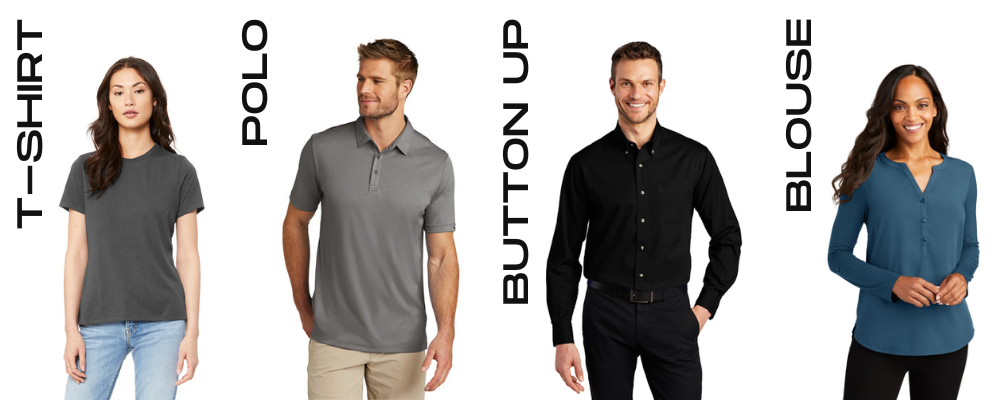
The “outerwear” moniker is applied to any type of garment worn over other clothing—essentially, anything that is not a shirt. The outerwear category includes the following:
- Jackets: Worn for warmth, protection, or fashion, jackets are available in various styles, lengths, and materials. For instance, “puffer” jackets are characterized by a polyester shell featuring a distinctive quilted or padded design and stuffed with down to insulate against extremely cold weather. Other types of jackets are designed to shield the wearer from wind and rain, or to add a stylish layer to an outfit.
- Sweatshirts: Another broad category of apparel, sweatshirts are typically made from soft, comfortable materials like cotton or fleece and are designed for casual wear, either alone or over a shirt. One popular type of sweatshirt is a hoodie, which includes—as the name implies—a hood. Characterized by their loose fit and long sleeves, sweatshirts include a front opening that can be closed with a zipper, buttons, or simply pulled over the head.
- Vests: A sleeveless upper-body garment that is typically worn over a shirt, blouse, or other tops such as sweatshirts. Vests can be both functional and decorative, and they come in various styles, materials, and lengths.
- Sweaters: Essentially a more stylish version of a sweatshirt, sweaters are knitted or crocheted garments typically made of wool, cotton, or synthetic fibers and designed to provide warmth in chilly conditions. Available in various styles, shapes, and thicknesses, making them suitable for virtually all seasons and occasions, sweaters are normally worn as an outer layer over other clothing, although they can also be worn alone as a fashionable option for casual events.
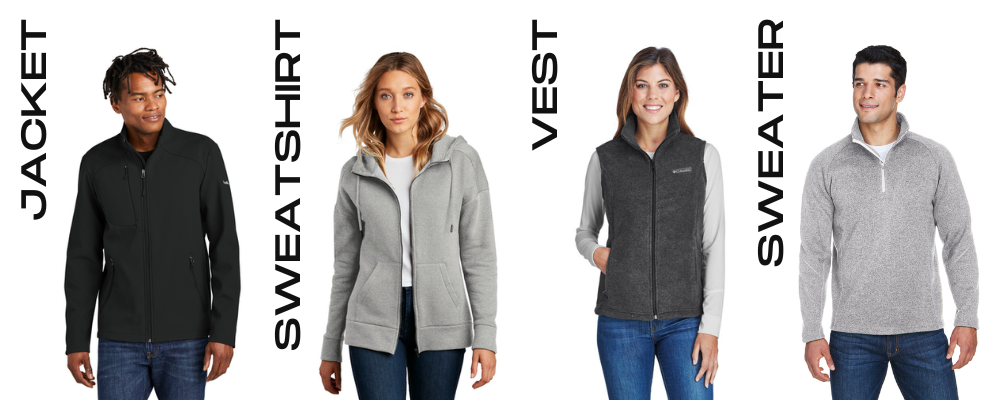
Common Apparel and Design Terms
Now that we’ve covered the broad categories of apparel, let’s explore the various terms that describe different characteristics or styles. This information may be common knowledge to many readers, but for those who are unfamiliar with fashion, this could prove useful when considering branded apparel for employees or customers.
Seam
Let’s start with the basics. A seam is the line where two pieces of fabric are joined together, usually through stitching.
Hemline
The hemline is the edge or border of a garment, typically used to describe the bottom. While hemlines may be generally understood, what’s less well known is that there are many different types. For instance:
- Straight hem: The most common hem style, where the bottom of the shirt or skirt is cut straight across, creating a clean, simple look. Straight hems are often found on casual T-shirts and dress shirts.
- High-low hem: A high-low hem, characterized by a shorter front and longer back, is frequently used in women's fashion for blouses and casual tops, providing a fashionable and slightly asymmetrical look.
- Drop hem: With a drop hem, the front and back extend further down than the sides of the garment.
- Tunic length: A loose-fitting garment with a hemline that falls somewhere between the hips and the knees.
- Crop: A crop shirt is one that is intentionally shortened, with the hem normally ending around or above the waistline. While crop tops can vary in length, most typically expose the midriff or a portion of the abdomen, and they all generally stop well above the natural waistline.
- Mid-crop: Less severe than a traditional crop top, a "mid-crop" garment is shortened to a length that falls somewhere between full length and a true crop. Think of it as a compromise, extending to the midsection of the torso or just below the natural waist.
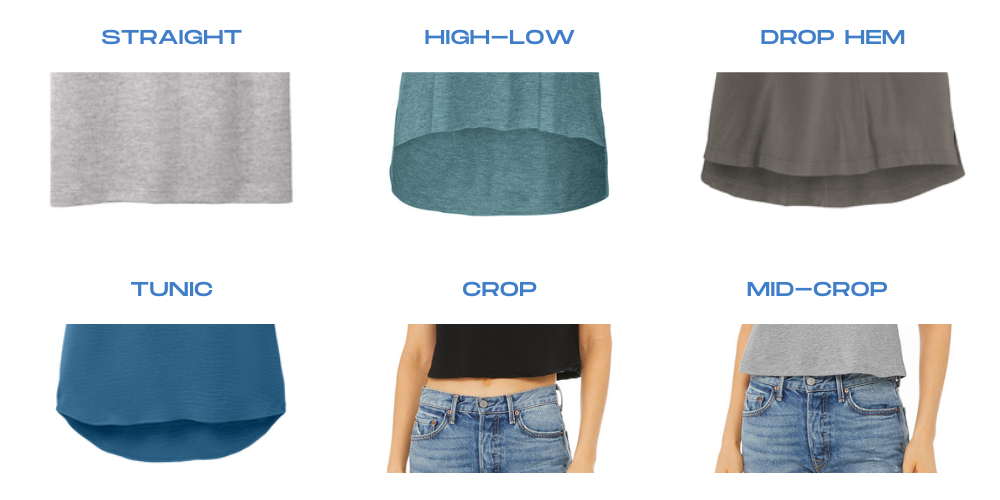
Sleeves
Everyone knows what a sleeve is. What they may not know is that there are several types of sleeves, seven of which are described below.
- Sleeveless: One type of sleeve is no sleeve at all. Sleeveless garments expose the entire arm. These include tank tops, certain blouses and dresses, and even some T-shirts. Sun’s out, guns out!
- Cuff: A cuff is the band or fold at the end of a sleeve (or pant leg, as the case may be).
- Cap: A cap sleeve is extremely short, covering only the top part of the shoulder. Cap sleeves are most often found on blouses, dresses, and other types of tops typically worn in warmer weather.
- Short: Short sleeves cover the shoulder and upper part of the arm but end above the elbow. T-shirts, casual shirts, polo shirts, summer dresses, and even some types of dress shirts feature short sleeves.
- Elbow-length: As the name suggests, elbow-length sleeves extend to or slightly below the elbow, providing a cool yet modest look. This type of sleeve is typically used on dresses, blouses, and other casual tops.
- Three-quarter: Again, the name is self-explanatory: this is a sleeve that covers about three-quarters of the arm, ending down to somewhere between the elbow and the wrist. As with most specialty length sleeves, the three-quarter sleeve is most often found on blouses, dresses, and other casual tops for a versatile and casual look.
- Full-length: Finally, a full-length sleeve extends the full length of the arm, covering the wrist. Most often found on men’s dress shirts and other business attire, as well as formal dresses and colder-weather garments, both shirts and outerwear.
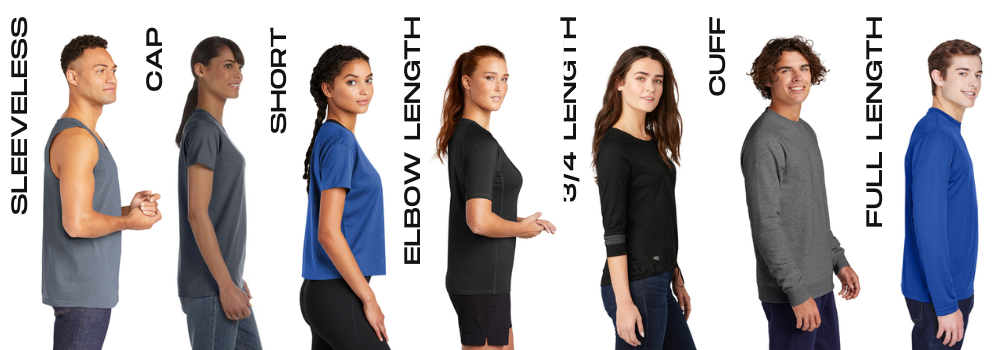
Neckline
The neckline of a garment describes the shape or design found around the neck. Many necklines are well known, others less so.
- V-neck: A neckline that dips into a V shape. Typically found in garments such as T-shirts, sweaters, and dresses.
- Cowl neck: Characterized by draped, loose fabric.
- Boat neck: A wide neckline that runs horizontally, essentially from shoulder to shoulder, sitting at or near the collarbone. Often used in women's tops and dresses.
- Crew neck: Classic and versatile, crew necks are a round, close-fitting neckline that sits at the base of the neck. Typically seen in T-shirts.
- Scoop neck: Wide and U-shaped, scoop necks curve gently between the shoulders. Used primarily in casual tops and dresses.
- Square neck: Cut at a right angle at the base of the neck to create a square shape. Structured and classic.
- Turtleneck: A high, close-fitting neckline that extends upwards to cover the neck. Turtlenecks can be folded or unfolded.
- Mock neck: Similar to a turtleneck, a mock features a high neckline that extends upwards but without the fold and extra fabric.
- Henley: A neckline with a partially buttoned vertical placket.
- Neck taping: Taping is a technique in garment construction that applies a strip of fabric or tape to the inside of the neckline, depending on the design.
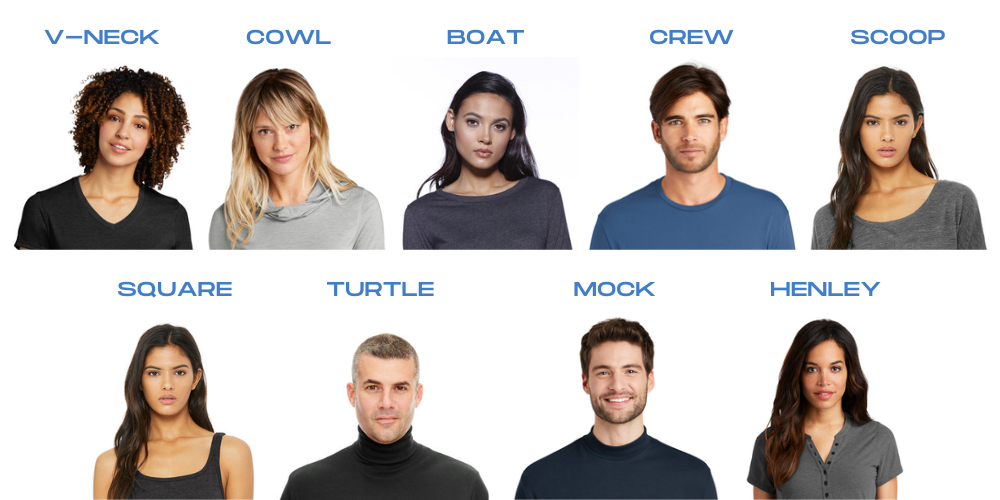
Design Terms
Various terms are used in the clothing and apparel business to describe different design styles and techniques. Here are a few of the most common phrases.
- Pleat: A fold or gather in fabric created by folding the material over itself and securing it in place. Pleats are used in clothing to add texture, dimension, and visual interest while also providing ease of movement.
- Placket: An opening or slit in a garment, often seen shirt fronts or at the wrist of a sleeve.
- Drawcords/drawstrings: Cords threaded through casings in fabric used to tighten or close an opening. Commonly used in clothing like sweatpants or gym shorts, bags, and other items to provide an adjustable closure. Hoodies and jackets may also have drawstrings around the hood.
- Color blocking: Describes apparel that has different colored fabric panels.
- 8K, 5K, 1K etc. protection: Refers to a material or garment’s waterproof or water resistance ratings, measured in millimeters. For example, a 5K rating means the material can withstand 5,000 millimeters of water pressure.
- Quarter zip: A zipper that starts at the neckline and extends a quarter of the way down the chest, allowing for some adjustability in the neck area.
- Half zip: A zipper starts at the neckline and extends to roughly the midsection of the garment, allowing for a wider opening and more ventilation when fully unzipped.
- Full zip: A zipper that runs the entire length of the front, allowing the garment to be fully opened or closed.
- Pullover: A garment, such as a sweater or sweatshirt, that is designed to be pulled over the head. It does not have a zipper, and the head opening is typically smaller than other garments.
- Soft shell: Breathable, stretchy, flexible fabric such as polyester blends with added elastane or spandex used in apparel that values comfort, breathability, and lightness. Soft shells are water resistant but are not intended for prolonged exposure to heavy rain or extreme weather.
- Hard shell: Rugged, durable material that protects against rain and harsh winds. Built to withstand extreme conditions, hard shells are great for activities like mountaineering, skiing, and other outdoor adventures where protection against the elements is crucial.
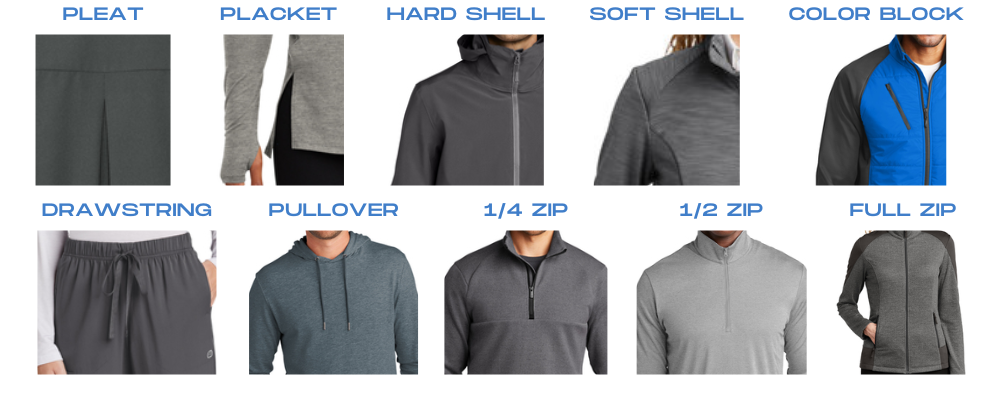 Hats and Other Headwear
Hats and Other Headwear
Hats are another type of outerwear that includes a number of variations and options. Hats can be broken down into two basic categories: structured and unstructured.
Structured hats feature a reinforced crown and a stiff front panel made of buckram or some other supportive material so that they maintain their shape, even when not being worn, ensuring a more defined and uniform shape. Baseball caps are an example of structured caps.
Unstructured hats don’t have the same support in the crown as structured hats, resulting in a softer and more flexible design that conforms to the shape of the wearer's head and reflecting a more natural and casual look. This category includes caps like beanies and knit hats.
Headwear Terms
Like apparel, hats and headwear use various terms to describe a style or design. These include:
- Hat panel: Hats are constructed of panels; the number of panels determine the type of cap. A five-panel cap has one large panel in front and four equal-sized panels on the sides and back, while a six-panel cap uses equal-sized panels throughout, with a middle stitch on the front.
- Beanie: Typically made of soft, stretchy fabric like knit wool, beanies fit snugly around the head and cover the ears to provide warmth and insulation in cold weather. Known for their simplicity and versatility, they are popular for casual, everyday wear.
- Snapback: A hat with a band on the back of a cap that allows you to adjust the size. These bands can be plastic snap closures, with holes on one strap and small buttons on the other that allow you to customize the fit; Velcro closure strips that provide for more granular sizing; or leather snap closures featuring a strip of cloth or leather with a buckle.
- Trucker cap: Similar to a snapback but with mesh backing and a foam front panel.
.png?width=1000&height=350&name=hat%20and%20headwear%20key%20terms%20(1).png)
OnFulfillment Is Your Apparel Source
Whether you’re supplying an event staff with matching corporate branded shirts or looking for high-end gifts for customers and partners, OnFulfillment can find what you’re looking for. To hear more about what we have to offer, just visit this link below to schedule a meeting.



